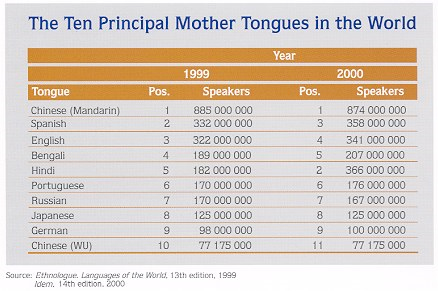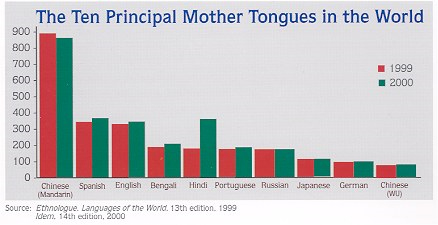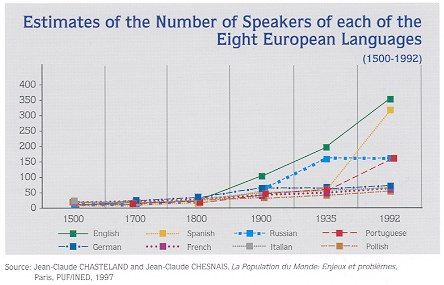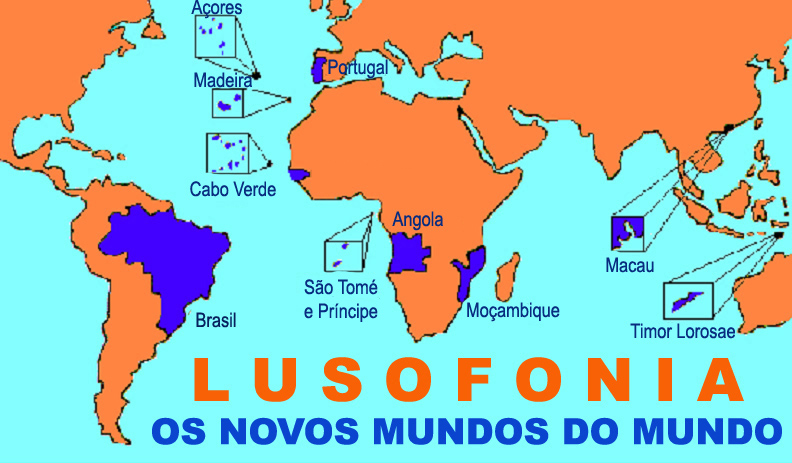|
| Recursos
na Rede - Sebenta Digital Lusófona
|
|
The
Portuguese Language: Perspectives for the 21st Century Text published by Instituto Camões in June 2001 |
 Author:
Jorge Couto |
At the initiative of the European
Council and the European Union, the European Year of Languages was celebrated
during 2001. This event constituted a powerful motive to enter into
a consideration of the role Portuguese fulfils, at a global level, in
this recently begun 21st century.
This exercise bears a particular relevance because the question of language
constitutes one of the major areas of ongoing debate at the heart of
international organisations involved in education and culture, such
as UNESCO and the European Council.
Given the crucial function of language in the genesis of cultures, the
growing debate over the defence of linguistic heritage - related to
contemporary concerns over the preservation of biodiversity and cultural
diversity - among both scientific bodies and diverse international institutions,
can be understood.
1. LINGUISTIC DIVERSITY
Statistics on living languages present different indicators but point, in general, to a grand total of more than 6000 languages in the world. According to the latest figures released by UNESCO, this number exceeds 6700.

The distribution
of living languages by geographic areas reveals, firstly, that Europe
has the lowest number of idioms - 225 which corresponds to a mere 3,4%
of the total - nevertheless, paradoxically, it is the continent where
concerns over their preservation have arisen with greater emphasis. Secondly,
the statistics show that the majority of languages are concentrated in
developing countries in the continents of Asia (32%) and Africa (30%).
This great linguistic diversity hides, nevertheless, an enormous disparity
between idioms, incorporating everything from those with about 900 million
speakers to others that are limited to fewer than 20 individuals. According
to recent calculations, 600 languages have more than 100 000 speakers,
while 500 others are confined to less than 100 speakers.
Many African, Asian and American languages are at risk of extinction,
with recent estimations stating that 25 languages disappear annually,
in other words, at a rate of one every two weeks.
An analysis of the factors which constitute a threat to the existence
of a language shows a strong correlation between geographic location (predominantly
in Asia and Africa), the stage of development of the particular country
and the minority status of numerous communities in contrast to the powerful
official languages. Take as an example those states that encompass more
than 200 languages: Papua-New Guinea (850), Indonesia (670), Nigeria (410),
India (380), Cameroon (270), Mexico (240) and the Democratic Republic
of the Congo (210) (1).
With the disappearance of a language it is not only a human being who
dies, but also a form of expressing a conception of the world, a means
of expressing a relationship with nature, an oral tradition, a poetry,
and ultimately a culture, thereby contributing to the global impoverishment
of humanity.
Therefore states, regions, societies and civic and cultural organisation
have sought, with the assistance of international organisations, to adopt
measures conducive to the preservation of languages, as these constitute
a priceless heritage, fulfilling a central role in the preservation of
the identity of numerous communities threatened on diverse continents,
as well as being indispensable factors in guaranteeing cultural diversity.
Portugal has recently taken steps in this regard. The country officially
recognised the Mirandesa language (spoken in the north eastern part of
Portugal and adjacent areas in Spain) in 1999, legislated its teaching
in the education system and played a leading role, and through the Ministry
of Foreign Affairs, in promoting the signing of the European Charter of
Regional or Minority Languages, approved in 1992 by the European Council.
2. MOTHER TONGUES
A number of warnings
by linguists and other social scientists, as well as international organisations
and civil servants from different parts of the world, have come to underline,
with growing intensity, the crucial factor of mother tongues in the development
of human creativity, of capacity to communicate, of the elaboration of
concepts and, above all, its primary role in cultural identity. These
concerns were mirrored in and gave rise to the Universal Declaration on
Language Rights, approved in Barcelona on 6 June 1996 during the World
Conference on Language Rights.
As a definitive means of contributing to the preservation of cultural
diversity and protection of the intangible heritage of humanity, the 30th
General Assembly of UNESCO, which took place in 1999, decided to celebrate
International Mother Tongue day on the 21st of February every year.
The first of these celebrations took place in the year 2000 with, on this
occasion, Kofi Annan, the Secretary General of the United Nations, saying
that in this era of globalisation, in which some languages are transformed
into global languages, it is fundamental that the local is preserved.
Koichiro Matsuura, the Director General of Unesco, accentuated the fundamental
importance and durability of the mother tongue which "fed, from the
tenderest age of infancy, the most intimate thoughts".
The Portuguese language occupied, until the beginning of the 20th Century,
a relatively modest position among the most important mother tongues in
the world. It was only from the first decades of the 1900s that it began
to acquire significant reach, an evolution which has been progressively
accentuated.

Estimates released in 1999 (www.sil.org/ ethnologue/top100.html) regarding
the 100 most spoken mother tongues in the world placed Portuguese in sixth
place, attributing to it a total of about 170 million speakers. The statistics
verified that among the ten mother tongues most widely spoken on the planet,
Portuguese was only superseded by Chinese (Mandarin), Spanish, English,
Bengali, Hindi, and occupied the position of third most widely spoken
European language, while it had a number of speakers identical to that
of Russian.
A interpolation of these facts with principles of geography and demographics
permit the conclusion that only the three most important European mother
tongues at the global level - Spanish, English and Portuguese - maintain
the highest number of speakers in individual countries outside of their
original areas, all of which are situated on the American continent, namely
Mexico, the United States of America and Brazil, respectively. On the
other hand, the three most important eastern languages do not possess
the status of mother tongue in states situated on other continents. The
European languages referred to have found, therefore, in the former colonies
of the Americas powerful vehicles for their global expansion, largely
outstripping that of the former metropoles.

The publication
of the figures relating to 2000, by virtue of the corrections introduced
relative to previous calculations, places Hindi as the second most widely
spoken mother tongue, and confirms the significant tendencies of the growth
of Spanish, English, Bengali and Portuguese. It is pleasing to note that
our language maintains its sixth position while Russian - which is credited
with the same number of speakers - registers an inversion in its growth
tendency thanks to the disintegration of the Soviet Union, a historic
event which, from a linguistic point of view, caused modifications that
will be far more visible in decades to come.
Despite the latest estimates of Ethnologue.Languages of the World bearing
a significant approximation of reality as far as Portuguese is concerned,
there is still a statistical underestimation. According to figures derived
from institutions responsible for the census of the populations of the
countries whose official language is Portuguese we can, while erring on
the side of caution as a means of reducing the margin of error, point
to a figure of 183 million people whose mother tongue is Portuguese, distributed,
by decreasing order of importance, on the continents of America, Europe,
Africa and Asia.
Preliminary results from the population census for 2000, released by the
Brazilian Institute of Geography and Statistics (www.ibge.gov.br) estimate
that the population of Brazil is 170 million inhabitants, recording an
annual expected growth rate of 1,93. The total figure ought to be reduced
by 320 000 Native Americans who have mother tongues belonging to diverse
American linguistic families and, at most, one million immigrants who
actually do not have the language of Machado de Assis as their mother
tongue.
The population of Portugal had reached 10 023 070 inhabitants by the end
of last year, according to figures made available by the National Statistics
Institute (2). For the first time in the past fifteen years, therefore,
the level of 10 million residents has been exceeded, a fact due not only
to an increase in births and decrease in deaths - the annual growth rate
is at 1,2 - but is also contributed to by immigration. It is estimated
that of all of Portugal’s residents 300 000, at most, do not have
Portuguese as their mother tongue.
The Second General Census of the Population and Habitation of Mozambique,
undertaken in 1997 (www.ine.gov.mz/censo2/00/brochura/00linguas.htm) reveals
that of a total of 12 536 800 inhabitants of age 5 and above, 6,5% have
Portuguese as their mother tongue, representing 814 892 individuals. It
is worth noting that there is a significant difference when dissecting
the total figure between rural and urban areas, as in the first category
this percentage falls to 2,0%, while for the second it increases to 17%.
Therefore, a large majority of Mozambican citizens who have the Portuguese
language as their mother tongue live in cities. This fact is exemplified
by the testimony of a young Mozambican writer, Nelson Saúte, who
recently affirmed that "my mother tongue is Portuguese. Yet the language
of my mother, actually , is Ronga and that of my father is Bitonga. These
I understand and speak". (3)
Angola is the African country where the Portuguese language is found more
vigorously entrenched. Calculations conducted by Angolan academics suggest
that Portuguese constitutes the mother tongue of 40% of the population,
estimated at 12 million inhabitants. It is not possible, however, to corroborate
these numbers statistically, by virtue of the large numbers of displaced
people and internal refugees affected by the conflict which afflicts the
country. Even reducing these estimates by half - as a matter of prudence
- it represents, at least, 2 million Angolans who have "the final
flower of Lacio" as their mother tongue.

Portuguese speaking
residents in other parts of the world - 4 631 482 according to a 1997
estimate (4) - contribute significantly to the expansion of the language
of Camoens in various parts of the world, with particular prominence in
the United States of America, Canada, France, Venezuela, South Africa,
Germany, Switzerland and Luxembourg. It is also worth noting that fact
that from the 1980s Brazil came to experience, for the first time in its
history, the phenomenon of emigration. The number of Brazilians living
in other countries has presently reached 1 374 000, with the following
distribution: 970 000 in North America, 250 000 in Asia, principally concentrated
in Japan, and 127 000 in Europe. It is certainly true that a percentage
of people of Portuguese descent do not have Portuguese as their mother
tongue, because of which the figures should be treated circumspectly,
nevertheless the joint contribution of Portuguese and Brazilian emigrants
probably exceeds, at least 3 million people.
The figures calculated allow the arrival at the firm conclusion that fault
can easily be found with the estimates put forward, even more so because
account has not been made of the contributions of three countries where
Portuguese is the official language (Cape Verde, Guinea-Bissau and Sao
Tome and Principe) or of territories such as East Timor and Macau. The
improvement of national statistical systems in the countries where Portuguese
is the official language will allow the possibility of applying greater
rigor to the calculation of the number of people for whom Portuguese is
their mother tongue.
The Portuguese language finds itself, therefore, particularly well positioned
in the context of the linguistic dispute being conducted on the international
stage, as it is one of those rare idioms that has the status of being
the mother tongue in states or territories on four continents.
3. GLOBAL LANGUAGE
Portuguese is actually
the sixth most widely spoken mother tongue on a global level, it is an
official language in seven countries on three continents - and, within
the short term, of eight countries in four continents - it is the working
language of twelve international organisations, and is used daily by about
200 million human beings.
The important position which Portuguese actually occupies in the global
linguistic panorama does not result, albeit, from the implementation of
a strategic programme which envisioned the attainment of this objective,
as Portugal did not associate a policy of ‘lusophonisation’
with its process of expansion, unlike the options adopted by other European
powers.
Portuguese was spread spontaneously by navigators, soldiers, merchants,
seamen and missionaries who, from the 15th century, covered the four corners
of the globe, from Ceuta (the northern point of Africa opposite Gibraltar)
to Japan.
The lack of union of some bond between the project of creation of an empire
and a respective linguistic component conferred on the process of the
expansion of the Portuguese language a type of dissemination which is
behind the origin of the appearance of diverse creoles in Africa, Asia
and America.
An analysis of estimates of the number of speakers of the eight principal
European languages - from the 16th century to the close of the 20th century
- shows that Portuguese barely began to gain prominence in the last century.
Until 1900 Portuguese was almost always placed in eighth position, with
the exception of 1700 in which it reached seventh position (4 million).
Only in 1935 did the idiom of Camoens begin a sustained process of growth,
reaching sixth position (47 million) and definitively surpassing Polish
and Italian. In 1992, according to estimates by the demographers Jean-Claude
Chasteland and Jean-Claude Chesnais, Portuguese rose to fourth position,
with 160 million speakers, as a result of a dovetailing of factors such
as the demographic growth in Brazil and Portugal and the development of
literacy programmes in African countries where the official language is
Portuguese (known as PALOP in the Portuguese acronym).
In the past few years, the consolidation of significant geopolitical mutations
which occurred in Europe, South America and Southern Africa have had particular
repercussions in the field of language usage. On the European continent
the dissolution of the Warsaw Pact and the Soviet Union provoked, in many
states of Central and Eastern Europe, a drastic reduction in the teaching
of Russian in their respective systems of education. The development of
the Southern African Development Community (SADC), which began life in
1980 and integrates the majority of the southern hemisphere African countries,
adopted Portuguese and English as the two official languages of the region.
Finally, in South America the creation, in 1991, of MERCOSUL caused a
significant alteration in the range of teaching of foreign languages,
conferring on Portuguese and Spanish the mantle of obligatory idioms in
the countries of the regional grouping.
It is in the light of the new realm of international relations in which
we find ourselves in the final period of the cold war that the phenomena
of regional integration, which is intensifying on four continents, stands
out with particular prominence, such that we are able to analyse the prospects
for the evolution of the Portuguese language in a global context.

Taking as a starting point the intersection of figures provided by regional
organisations in which Portuguese assumes the function of one of the official
languages, together with demographic projections by the United Nations
to 2050, we arrive at the conclusion that our language has major possibilities
for growth, as a language of international communication, both in Southern
Africa and South America.
3.1. SOUTHERN AFRICA
The PALOP constitute
a foundation of major importance for the expansion of Portuguese in Africa.
The option for the language of Camoens was taken by the nationalist movements
during the course of the struggle for liberation and resulted in the recognition
that its use went easily in tandem with the consolidation of political
and cultural borders of the future states, also contributing to the strengthening
of national unity at independence. Naturally this decision was lent some
weight by the examples of the contemporary processes of decolonisation
taking place in the rest of Africa, but also by the publication, in 1958,
of a classic work which emphasised the role of language in the construction
of unity in Brazil (5). The founder of the African Party for the Independence
of Guinea-Bissau and Cape Verde (PAIGC in the Portuguese acronym), Amílcar
Cabral (1924-1973) expressed this line of thought by affirming that "the
Portuguese language is one of the best things the Portuguese have left
us".
The potential for expansion of our language in Africa is extremely significant,
above all in the southern hemisphere. Besides the PALOPs, whose population
will increase, according to UN estimates, to 58 million by 2025 and 83
million by 2050, there is a notable growth in requests for teaching of
Portuguese at the different levels of education in the countries which
make up the SADC, particularly in South Africa, Namibia and Zimbabwe.
An identical trend is being seen in the various states of the Economic
and Monetary Union of West Africa (UEMOA in the French acronym) and the
Economic Community of West African States (ECOWAS), with special relevance
in the cases of Senegal (with more than 10 000 students of Portuguese
in secondary and higher education), the Ivory Coast and Gabon.
3.2. SOUTH AMERICA
The recent phenomenon
of regional integration which led to the creation of MERCOSUL is contributing
suddenly to a reciprocal movement for the teaching of Portuguese and Spanish
in the member countries. An association of this new and dynamic element
with demographic projections reveals that there is a vast space for an
exponential growth in the teaching of Portuguese in Argentina, Uruguay
and Paraguay (MERCOSUL members together with Brazil), together with a
total population of 44,5 million people and which will be about 60 million
in 2025 and 71 million in 2050.
These possibilities are already in various stages of implementation according
to the most recent facts available. In the final quarter of last year,
a report in the Argentinian newspaper Clarin made it clear that "Portuguese,
the other idiom of the MERCOSUR" was taught in institutions, universities,
primary and secondary schools, reaching thousands of Argentinians who
are studying it throughout the country.

The teaching of our language is already compulsory in various provinces
(Formosa and Santa Fe) and the Secretary of Education in the Municipality
of Buenos Aires has initiated a bilingual teaching programme in primary
schools in the capital. According to a survey released in February of
last year, the Gazeta Mercantil (a newspaper based in Sao Paulo, Brazil)
showed that of the total number of 300 language schools in Argentina,
Portuguese took second place as most common foreign language, with the
same trend occurring in Uruguay and Paraguay, as well as in other Latin
American countries which are not MERCOSUL members, such as Chile, Venezuela
and Mexico.
3.3. OTHER REGIONS
In August 2000, the
National Council of the Timorese CNRT decided to adopt Portuguese as the
official language of East Timor, a decision which will bring to eight,
in the near future, the number of states whose official language is Portuguese,
across four continents.
This was a strategic decision full of symbolism (6), recently confirmed
by a government emerging from the first free elections in that territory,
which permitted the CPLP (Portuguese acronym for Community of Countries
of the Portuguese Language) to count among its members one from the Asian
continent.
The concretisation of the project of the leaders of East Timor demands
concerted support from among the countries whose official language is
Portuguese as a means of reaching, in the medium term, the desired objective.
The creation in Asia of a state whose official language is Portuguese
will favour the teaching of Portuguese in diverse countries of the continent,
a phenomenon which is already being seen, for example, in Indonesia, the
Philippines and in Vietnam, with a parallel growth in the number of students
of the language also being registered in Japan, China, andSouth Korea.
It has also stimulated interest in our language in Goa, Damao and Diu
(all in India), Malaca (Malaysia) and the Special Administrative Region
of Macau (China), which are all regions where segments of the population
speak Portuguese or creoles with a lexical basis in Portuguese.
The development of economic and cultural relations based on the presence
of substantial Portuguese communities has created favourable conditions
for the expansion of Portuguese language teaching, be it in the European
Union, with particular relevance for France, Spain, Germany and Luxembourg,
or be it in North America (United States of America and Canada). In various
countries of Central and Eastern Europe a substantial surge in the learning
of Portuguese has been noted, especially in secondary schools, with a
concentration of cases in Romania, Hungary, Russia and Bulgaria.
The available evidence clearly points to a growth in the adoption of Portuguese
in the SADC and MERCOSUL, which trend is being spread into the adjacent
countries. "Our Magnificent Portuguese Language" (Nossa Magna
Lingua Portuguesa) as Fernando Pessoa put it, therefore shows a great
vitality which translates into a notable process of expansion on diverse
continents on the eve of the first half of the 21st century.
Notes:
(1)HAGÈGE, Claude, Haute à
la mort des Langues, Paris, Éditions Odile Jacob, 2000.
(2) Projecções de População Residente 1995-2025.
(3) Interview with Maria Teresa Horta, pub. in Diário de Notícias,
nº 48 189, de 28 de Fevereiro de 2001.
(4) MNE/DGACCP/Divisão de Informação e Documentação.
(5) LIMA SOBRINHO, Barbosa, A Língua Portuguesa e a Unidade do
Brasil, 2ª ed., Rio de Janeiro, Editora Nova Fronteira, 2000.
(6) HULL, Geoffrey, Timor-Leste. Identidade, Língua e Política
Educacional, Lisboa, Instituto Camões, 2001.

